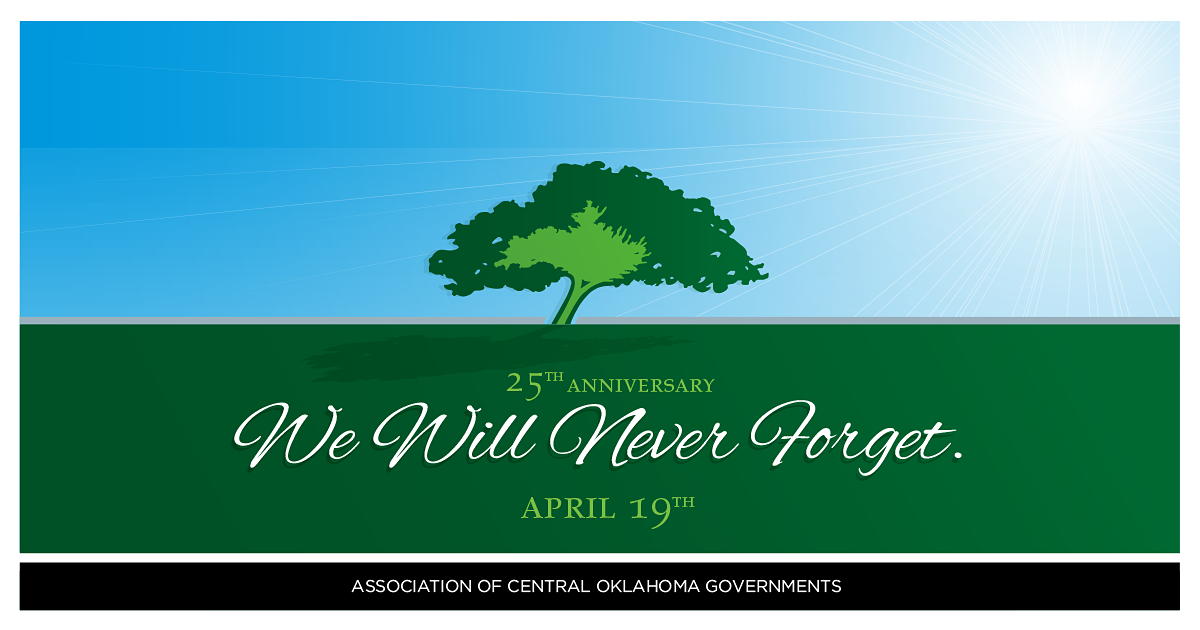
We Will Never Forget
ACOG Staff Remembers April 19, 1995
A flashbulb memory is a highly detailed, vivid recollection of a moment in time that carries significant or surprising news; such as the birth of a child or the death of a loved one.
These snapshot memories often cement themselves into our psyche – you might remember what you were doing, or where you were, maybe even what you were wearing when you learned of significant news.
For Oklahomans and especially residents of the Oklahoma City metro area, the morning of April 19, 1995 is a moment in time that will be seared into our collective memory and that has been the catalyst of forming the city’s identity and resiliency.
That fateful morning dawned as a normal, sunny, and beautiful Oklahoma spring day. By 9:03 a.m. the idyllic, innocent personality of downtown OKC was shattered as smoke rose from the Alfred P. Murrah Federal Building.
Five miles north, in the Executive Office Park off the Broadway Extension, the Association of Central Oklahoma Governments (ACOG) officed on the second floor of a building that was also occupied by the Oklahoma State Bureau of Investigations (OSBI).
“I was in Jane’s [Sutter] office when it happened, and it first sounded like something on our building blew up,” Julie Smedlund, ACOG IT & Facilities Management Director said. “We saw white smoke from downtown as we looked through the south windows. After a minute or so, the smoke turned black.”
As all eyes turned toward downtown OKC, the calls started flooding into the ACOG office, checking on friends and loved ones.
John Harrington, ACOG Water Resources Division Director, who would’ve been across from the Murrah building that day if his meeting at the Oklahoma Water Resource Board hadn’t been cancelled, remembers his office window shaking. “A few minutes later Larry Simpson, our other ACOG geologist at the time, came into my office. His wife, who worked at Presbyterian Hospital, called and told him the Federal building had been bombed. She wouldn’t be coming home that night with the number of estimated injured coming their way,” he said.
ACOG staff headed to the conference room to turn the TV to local news after hearing helicopters flying over the building. “The news reporter said, ‘half the building is gone’ and I remember a staff member responding, ‘it doesn’t look that bad.’ The more we watched, the more silent we all became,” Smedlund remembers.
“We lost one of our Federal Highway Administration contacts that day: Johnny Wade,” Beverly Garner, ACOG Executive Assistant said. After the explosion, ACOG’s office building was put on lockdown by the OSBI and all ACOG staff members were sent home for the remainder of the day.
After 9:03 a.m. on April 19, OKC found its way on the road to rebirth and recovery and ACOG was there every step of the way.
“ACOG’s involvement regarding recovery after the fact was primarily to support first responders in any way we could,” Jane Sutter said.
Jane Sutter, who is the current CEO of the Boys and Girls Clubs of Oklahoma County and who served as the ACOG Intergovernmental Services Division Director at the time of the bombing, remembers that the community relationship building that ACOG had been involved in previous years helped OKC with the recovery process.
“Many believed that the work we had done to bring community partners together in the Central Oklahoma 2020 visioning process a year or so before, was one of the reasons the community pulled together with such strength. The fact that so many agencies, elected officials, and community leaders had worked together for several months on that visioning process really helped communications and joint efforts come together as quickly as they did,” she said.
As the city began to rise out of the ashes, OKC Mayor Ron Norick appointed a 350-member task force to explore ways to remember this tragic event and honor those killed. ACOG Public Information Officer (PIO) at the time, Yvonne Maloan, worked for several months with the survivors and victims’ families to create the Mission Statement that set the stage for the creation of the Oklahoma City Memorial.
“Yvonne met regularly with family members who had lost someone in the bombing, as well as survivors, to collectively identify what they wanted to see created in a memorial, as well as to find collective words to express their sorrow and hopes regarding lessons learned,” Sutter said.
From those meetings of listening and reflecting with those that were most affected, Maloan penned the words that are spoken each year on April 19:
“We come here to remember those who were killed, those who survived, and those changed forever. May all who leave here know the impact of violence. May this memorial offer comfort, strength, peace, hope and serenity.”
This message of comfort and peace still rings true 25 years later to a city that has faced an unimaginable tragedy and is now currently facing a public health crisis. As we mark this anniversary, let us remember and never forget the 168 Oklahomans who lost their lives on that fateful April day.

